holistic gastrointestinal lymphoma support

free shipping over $100 (USA & Canada)
1-877-937-4372 the pet expert hotline

If your feline friend was diagnosed with cancerous tumors in different parts of the digestive system, you might be dealing with GI lymphoma in cats. In this brief guide, we’ll explore the causes, signs, diagnosis, treatment options, and essential care tips when dealing with gastrointestinal lymphoma in your furkiddo.
Lymphoma is a specific form of cancer originating from lymphocytes, a type of white blood cell that plays a crucial role in your pet’s immune system. In gastrointestinal or GI lymphoma in cats, these lymphocytes undergo abnormal changes and multiply uncontrollably, forming cancerous tumors or infiltrating the walls of the digestive tract, stomach, small intestine, large intestine (colon), and sometimes even the liver or pancreas. As the lymphoma cells accumulate in these organs, they can disrupt the normal structure and functioning of the digestive system.
The exact cause of gastrointestinal lymphoma in cats is not fully understood. However, factors like genetics and immune system function may play an important role. It’s important to note that this condition is not directly linked to diet or lifestyle. However, cats affected with FeLV (Feline Leukemia Virus) are more susceptible to GI lymphoma.
Cats with gastrointestinal lymphoma can exhibit a range of clinical signs, including:
There are different subtypes of GI lymphoma in cats, with some variations in how they present and behave. These subtypes may have different degrees of aggressiveness, response to treatment, and overall prognosis. Early and accurate diagnosis with the help of your local vet is essential for developing an appropriate and timely treatment plan.
To diagnose GI lymphoma in cats, the veterinarian may perform several tests, including blood tests, diagnostic imaging, endoscopy, and histopathology (biopsy). These diagnostic tools work together to provide a comprehensive understanding of the disease, allowing veterinarians to tailor treatment plans to the specific needs of the individual cat.
Blood Tests:
Blood tests are often one of the initial steps in diagnosing gastrointestinal lymphoma. These tests can reveal abnormalities in the blood, such as changes in white blood cell counts, which may indicate the presence of cancer. Elevated levels of specific proteins in the blood may also suggest lymphoma. While blood tests are valuable, they are typically used in conjunction with other diagnostic methods for a more comprehensive assessment.
Diagnostic Imaging (X-rays or Ultrasound):
X-rays and ultrasound are non-invasive imaging techniques that can provide valuable information about the cat’s internal organs. X-rays may reveal changes in the size or appearance of organs in the abdominal area. Ultrasound allows for more detailed visualization of the abdominal organs, helping to identify abnormalities like thickened intestinal walls or enlarged lymph nodes. These imaging studies are essential for understanding the extent and location of lymphoma.
Endoscopy:
Endoscopy is a procedure where a flexible tube with a camera at its tip (endoscope) is inserted into the cat’s digestive tract through the mouth or anus. This method allows veterinarians to visualize the stomach and intestines directly and take tissue samples (biopsies) if abnormal areas are found. Endoscopy is a crucial diagnostic tool for confirming the presence of gastrointestinal lymphoma and obtaining tissue samples for further analysis.
Histopathology (Biopsy):
Histopathology involves the examination of tissue samples under a microscope to identify abnormalities at the cellular level. In the case of gastrointestinal lymphoma, biopsies are taken during endoscopy or through surgical procedures. These tissue samples are then sent to a laboratory for histopathological analysis. This analysis confirms the diagnosis of lymphoma and provides critical information about the type and extent of the cancer, which guides treatment decisions.
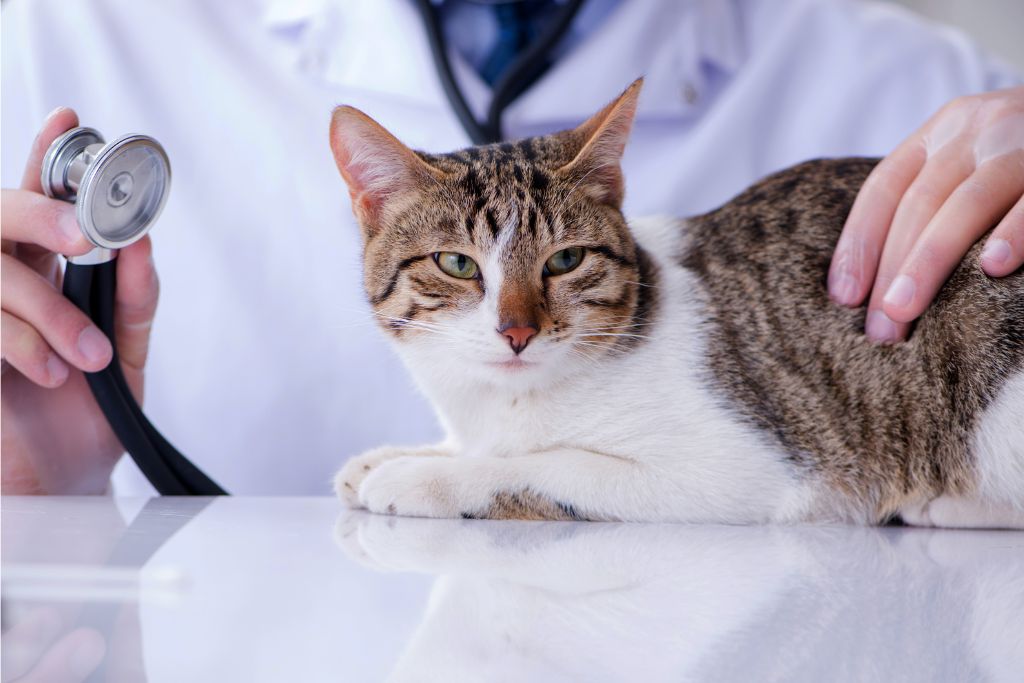
Treatment options for gastrointestinal lymphoma may include chemotherapy, which can help slow the progression of the disease and improve your cat’s quality of life. In some cases, surgery or radiation therapy may be considered. Your vet will help you decide the best course of action based on your cat’s condition.
Supplements can play a supportive role in managing Gastrointestinal Lymphoma in cats. Here are a few of our vet-formulated blends that can help:
NHV Felimm: Lymphomas originate as an abnormal change of lymphocytes and malfunctioning of the lymphatic system. Felimm may help balance the dysregulated immune system while detoxicating it. Further, it may help fight against Feline Leukemia (FeLV), a predisposing factor for Lymphomas. Moreover, it may stimulate the appetite and improve the energy levels of your little one.
NHV Milk Thistle: is well known for its detoxifying capabilities on the liver and kidneys. Hence, it may be more beneficial in removing toxins that can build up in your pet’s vitals during cancer chemotherapy and from chemical-laden foods. Further, its antioxidant properties may benefit as anticancer support.
NHV Yucca: Corticosteroids are anti-inflammatory agents that are often used in the treatment of lymphomas. Yucca Contains steroidal saponins that help stimulate the body to produce its natural corticosteroids. Hence, it reduces discomfort and inflammation. Further, it may Promote digestion and stimulate appetite that may be compromised due to lymphoma.
NHV Plantaeris: Helps support the normal functionality of the bowel while soothing and relieving spasms of the gastrointestinal tract. Further, it helps reduce discomfort associated with alimentary lymphoma.
Felimm, Milk Thistle, Yucca, and Plantaeris can be found on our NHV Gastrointestinal Lymphoma Support Kit at a discounted price.
Provide a Comfortable Environment:
Create a peaceful and low-stress environment for your cat. Stress can exacerbate symptoms of lymphoma and affect their overall well-being. Minimize loud noises, ensure they have a quiet place to rest, and offer them comfort and attention.
Ensure Access to Clean Water:
Hydration is crucial for cats with gastrointestinal lymphoma, especially if they are experiencing vomiting or diarrhea. Make sure your cat always has access to fresh, clean water. You might consider using multiple water bowls around your home to encourage drinking.
Choose the Right Diet:
Consult with your veterinarian to select an appropriate diet for your cat. They may recommend a homemade personalized diet or suggest certain commercial cat foods that are formulated for cats with gastrointestinal issues. These diets are designed to be easily digestible and gentle on the stomach.
Offer Emotional Support:
Provide your cat with emotional support. Spend quality time with them, offer gentle affection, and ensure they feel loved. Cats with cancer can benefit from the emotional bond with their owners, which can help improve their overall quality of life.
Caring for a cat with gastrointestinal lymphoma requires patience, understanding, and a strong partnership with your veterinarian. By creating a nurturing environment, managing their diet, and staying vigilant about their health, you can provide the best possible care for your feline companion during this challenging time.
holistic gastrointestinal lymphoma support

Felimm, Milk Thistle, Yucca & Plantaeris
bundle and save with pet expert kits
3 month supply for a small to medium size pet
What is it?
This vet-formulated kit helps give extra support to your furkiddo while they fight against gastrointestinal lymphoma. These pet supplements help detoxify the lymphatic system, stimulate the appetite, protect organs from the side effects of chemotherapy, aid in reducing inflammation, discomfort and help normalize bowel movements— all very common issues faced by pets affected by this condition.
How does it work?
Why should I trust it?
NHV has helped 1000s of pets through the decades, like sweet Mimi with gastrointestinal lymphoma.


What is it?
This vet-formulated kit helps give extra support to your furkiddo while they fight against gastrointestinal lymphoma. These pet supplements help detoxify the lymphatic system, stimulate the appetite, protect organs from the side effects of chemotherapy, aid in reducing inflammation, discomfort and help normalize bowel movements— all very common issues faced by pets affected by this condition.
How does it work?
Why should I trust it?
NHV has helped 1000s of pets through the decades, like sweet Mimi with gastrointestinal lymphoma.

Gastrointestinal lymphoma, also known as alimentary lymphoma, is one of the most common kinds of lymphoma in cats, especially. It is characterized by the presence of a solitary mass, multiple masses with or without regional intra-abdominal lymph node involvement, or as a diffusely infiltrating disease of one or more parts of the bowel. The cause is not well understood, but factors like genetics, FeLV and environmental factors such as exposure to cigarette smoke can play an important role.
As the alimentary form can affect any part of the stomach or intestines, it often causes symptoms like weight loss, lethargy, loss of appetite, vomiting, and diarrhea. An abdominal mass can also develop and might be felt on a physical examination. Some pets may experience enlargement of organs like liver and spleen as well.
A powerful complete kit
The herbs these formulations have anti-inflammatory, antioxidant and nutritive properties that will help provide support with the symptoms of gastrointestinal lymphoma, detoxify the lymphatic system, stimulate the appetite, balance the immune system and ease the discomfort, lethargy, inflammation and discomfort caused by it.
Felimm
Milk Thistle
Yucca
Plantaeris
Gastrointestinal Support kit is vet formulated with all-natural products and contains four powerful supplements: NHV’s Felimm, NHV’s Milk Thistle, NHV’s Yucca and NHV’s Plantaeris, which are combined to help relieve symptoms of gastrointestinal lymphoma and balance your pet’s immune system.
If you have questions about holistic remedies, you can ask an expert at NHV because we want your pet to get healthy naturally.
Felimm: This formula helps to balance the immune system that is dysregulated in a pet with Lymphoma. It also helps fight against Feline Leukemia (FeLV) that may be related to Lymphoma and other viral infections. In addition, it helps fight infections, encourages detoxication of the lymphatic system, stimulates the appetite, improves energy levels, and helps combat upper respiratory tract infections.
St. John’s Wort— Has powerful antiviral properties that help control viral infections and stimulates your pet’s immune system.
Turmeric – A powerful antioxidant that helps fight the damaging effects of free radicals. It strengthens liver function and contains strong anti-fungal properties.
Aloe Vera – Anti-inflammatory, antibacterial, antioxidant and immuno-stimulating herb.
Alfalfa – Contains high levels of antioxidants. It also contains nutrients beneficial to pets with immune disorders.
Burdock – Helps cleanse the body of toxins and waste that accumulate during illness.
Cat’s Claw – A powerful anti-inflammatory and antioxidant that supports your pet’s immune system and helps strengthen its defenses against viruses like FeLV.
Osha – A natural immune builder that helps pets fight infections including FeLV and FIV. It also has antibacterial and antiviral properties.
Dandelion – A highly nutritious food that improves digestion and stimulates appetite. It also protects the kidneys and has anti-inflammatory properties.
Gotu Kola– An antioxidant-rich herb known to strengthen the immune system and protect cells from damage caused by free radicals.
Usnea – An immune system stimulant with anti-bacterial and anti-fungal properties that help protect your pet’s weakened immune system.
Goldenseal – An immune supporting herb with blood cleansing properties.
Myrrh – Helps control bacterial infections that pets with compromised immune systems are so vulnerable to
Milk Thistle: Chemotherapy has many side effects, such as toxicity of the organs, unfortunately. Milk Thistle can help prevent and decrease these toxicities since it can detoxify liver and kidneys by removing toxins that can build up in a pet`s system when taking pharmaceutical or chemical-laden foods. Improves liver and kidney function supports regeneration of the liver and supports overworked kidney. It also has antioxidant properties and may benefit as anticancer support. Milk Thistle contains a compound called silymarin which flavonoids contains strong anti-inflammatory, antioxidant and detoxifying properties. It also promotes cellular regeneration and repair.
Yucca: As corticosteroids are often used in the treatment of lymphoma and Yucca contain steroidal saponins, it can be very useful for pets suffering from Alimentary Lymphoma. This is well researched and reported that these steroidal saponins present in Yucca stimulate the body to produce its own natural corticosteroids. Our Yucca is formulated and dosed specifically to be safe for long term use in pets. It has been used successfully. Commonly used as an anti-inflammatory, nutritive, antitumor, and digestive supplement.
Plantaeris: It helps maintain normal bowel functions, soothes and relieves spasms of the digestive tract and reduces discomfort of pets suffering from Gastrointestinal Lymphoma.
Barberry – Treats inflammation and infections.
Mullein – Soothes and lubricates tissues of the GI tract.
Bayberry – Contains tannins, resins, and gums that control bacterial infection.
Myrrh – Relieves spasms, inflammation, and digestive discomfort.
Thyme – Improves digestion and relaxes GI spasms.
Chamomile – Relaxes the digestive system.
Chinese Peony – Reduces inflammation and relaxes spasms.
Ginger – Relieves discomfort and stimulates circulation.
Oregon Grape – Helps relieve indigestion and malabsorption.
Select your pet's weight to determine the correct dose.
DOSAGE:
To be taken twice daily. All NHV supplements are designed to be used together, and can therefore be given at once for convenience.
Maintenance Dosage
1 drop for every 2 lb of body weight twice a day up to 50 lb. This is the minimum dosage. We recommend using this dosage when the supplements are being used as proactive care or for general health. When addressing a condition, we recommend using the therapeutic dosage (see below).
Determine your pet’s weight and then use the chart below to determine the correct dose.
Pet's Weight Dosage (twice daily)
0 - 15 lb 0.5 mL
16 - 30 lb 1.0 mL
31 - 45 lb 1.5 mL
46 - 60 lb 2.0 mL
61 - 75 lb 2.5 mL
Over 75 lb 3.0 mL
How to Administer
Shake well before use. The easiest method is to use the dropper provided and squirt directly into the pet’s mouth or add the correct dosage to your pet's food or favorite treat.
Some pets can be finicky, if this occurs consider hiding the drops in foods most pet’s love such as fish, chicken or yogurt or a favorite treat. If your pet only eats dry food then soak a few kibbles at feeding time.
For Best Results
Herbal dietary supplements are beneficial to the health and wellbeing of your pet and are safe for long-term use. Every pet responds to natural herbal supplements differently, therefore it is important to be consistent and administer the product daily. Supplements generally take two to four weeks to take effect, however this will vary from one animal to the another.
Product Storage
All NHV Natural Pet Products are pure herbal extracts and contain no added artificial additives, preservatives or coloring. Shelf life after opening is 6 months and must be refrigerated after opening
Gastrointestinal lymphoma, also known as alimentary lymphoma, is one of the most common kinds of lymphoma in cats, especially. It is characterized by the presence of a solitary mass, multiple masses with or without regional intra-abdominal lymph node involvement, or as a diffusely infiltrating disease of one or more parts of the bowel. The cause is not well understood, but factors like genetics, FeLV and environmental factors such as exposure to cigarette smoke can play an important role.
As the alimentary form can affect any part of the stomach or intestines, it often causes symptoms like weight loss, lethargy, loss of appetite, vomiting, and diarrhea. An abdominal mass can also develop and might be felt on a physical examination. Some pets may experience enlargement of organs like liver and spleen as well.
A powerful complete kit
The herbs these formulations have anti-inflammatory, antioxidant and nutritive properties that will help provide support with the symptoms of gastrointestinal lymphoma, detoxify the lymphatic system, stimulate the appetite, balance the immune system and ease the discomfort, lethargy, inflammation and discomfort caused by it.
Felimm
Milk Thistle
Yucca
Plantaeris
Gastrointestinal Support kit is vet formulated with all-natural products and contains four powerful supplements: NHV’s Felimm, NHV’s Milk Thistle, NHV’s Yucca and NHV’s Plantaeris, which are combined to help relieve symptoms of gastrointestinal lymphoma and balance your pet’s immune system.
If you have questions about holistic remedies, you can ask an expert at NHV because we want your pet to get healthy naturally.
Felimm: This formula helps to balance the immune system that is dysregulated in a pet with Lymphoma. It also helps fight against Feline Leukemia (FeLV) that may be related to Lymphoma and other viral infections. In addition, it helps fight infections, encourages detoxication of the lymphatic system, stimulates the appetite, improves energy levels, and helps combat upper respiratory tract infections.
St. John’s Wort— Has powerful antiviral properties that help control viral infections and stimulates your pet’s immune system.
Turmeric – A powerful antioxidant that helps fight the damaging effects of free radicals. It strengthens liver function and contains strong anti-fungal properties.
Aloe Vera – Anti-inflammatory, antibacterial, antioxidant and immuno-stimulating herb.
Alfalfa – Contains high levels of antioxidants. It also contains nutrients beneficial to pets with immune disorders.
Burdock – Helps cleanse the body of toxins and waste that accumulate during illness.
Cat’s Claw – A powerful anti-inflammatory and antioxidant that supports your pet’s immune system and helps strengthen its defenses against viruses like FeLV.
Osha – A natural immune builder that helps pets fight infections including FeLV and FIV. It also has antibacterial and antiviral properties.
Dandelion – A highly nutritious food that improves digestion and stimulates appetite. It also protects the kidneys and has anti-inflammatory properties.
Gotu Kola– An antioxidant-rich herb known to strengthen the immune system and protect cells from damage caused by free radicals.
Usnea – An immune system stimulant with anti-bacterial and anti-fungal properties that help protect your pet’s weakened immune system.
Goldenseal – An immune supporting herb with blood cleansing properties.
Myrrh – Helps control bacterial infections that pets with compromised immune systems are so vulnerable to
Milk Thistle: Chemotherapy has many side effects, such as toxicity of the organs, unfortunately. Milk Thistle can help prevent and decrease these toxicities since it can detoxify liver and kidneys by removing toxins that can build up in a pet`s system when taking pharmaceutical or chemical-laden foods. Improves liver and kidney function supports regeneration of the liver and supports overworked kidney. It also has antioxidant properties and may benefit as anticancer support. Milk Thistle contains a compound called silymarin which flavonoids contains strong anti-inflammatory, antioxidant and detoxifying properties. It also promotes cellular regeneration and repair.
Yucca: As corticosteroids are often used in the treatment of lymphoma and Yucca contain steroidal saponins, it can be very useful for pets suffering from Alimentary Lymphoma. This is well researched and reported that these steroidal saponins present in Yucca stimulate the body to produce its own natural corticosteroids. Our Yucca is formulated and dosed specifically to be safe for long term use in pets. It has been used successfully. Commonly used as an anti-inflammatory, nutritive, antitumor, and digestive supplement.
Plantaeris: It helps maintain normal bowel functions, soothes and relieves spasms of the digestive tract and reduces discomfort of pets suffering from Gastrointestinal Lymphoma.
Barberry – Treats inflammation and infections.
Mullein – Soothes and lubricates tissues of the GI tract.
Bayberry – Contains tannins, resins, and gums that control bacterial infection.
Myrrh – Relieves spasms, inflammation, and digestive discomfort.
Thyme – Improves digestion and relaxes GI spasms.
Chamomile – Relaxes the digestive system.
Chinese Peony – Reduces inflammation and relaxes spasms.
Ginger – Relieves discomfort and stimulates circulation.
Oregon Grape – Helps relieve indigestion and malabsorption.
Select your pet's weight to determine the correct dose.
DOSAGE:
To be taken twice daily. All NHV supplements are designed to be used together, and can therefore be given at once for convenience.
Maintenance Dosage
1 drop for every 2 lb of body weight twice a day up to 50 lb. This is the minimum dosage. We recommend using this dosage when the supplements are being used as proactive care or for general health. When addressing a condition, we recommend using the therapeutic dosage (see below).
Determine your pet’s weight and then use the chart below to determine the correct dose.
Pet's Weight Dosage (twice daily)
0 - 15 lb 0.5 mL
16 - 30 lb 1.0 mL
31 - 45 lb 1.5 mL
46 - 60 lb 2.0 mL
61 - 75 lb 2.5 mL
Over 75 lb 3.0 mL
How to Administer
Shake well before use. The easiest method is to use the dropper provided and squirt directly into the pet’s mouth or add the correct dosage to your pet's food or favorite treat.
Some pets can be finicky, if this occurs consider hiding the drops in foods most pet’s love such as fish, chicken or yogurt or a favorite treat. If your pet only eats dry food then soak a few kibbles at feeding time.
For Best Results
Herbal dietary supplements are beneficial to the health and wellbeing of your pet and are safe for long-term use. Every pet responds to natural herbal supplements differently, therefore it is important to be consistent and administer the product daily. Supplements generally take two to four weeks to take effect, however this will vary from one animal to the another.
Product Storage
All NHV Natural Pet Products are pure herbal extracts and contain no added artificial additives, preservatives or coloring. Shelf life after opening is 6 months and must be refrigerated after opening
immune support
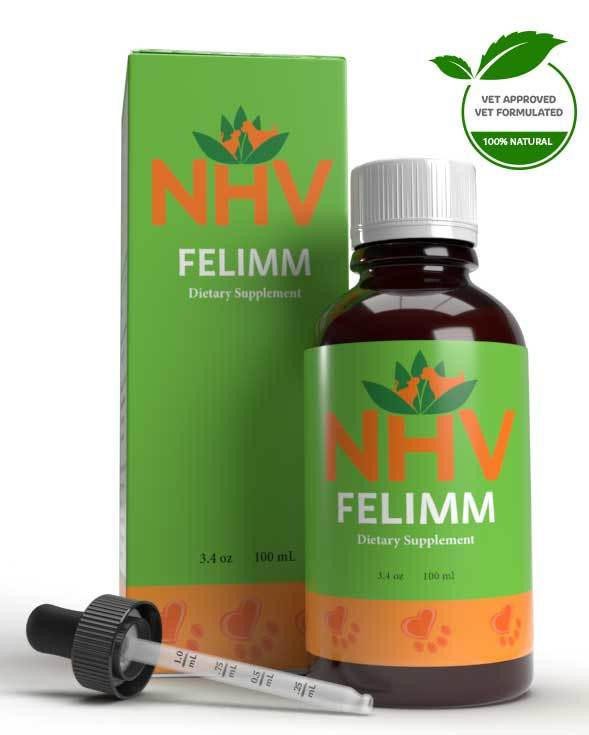
Helps your pet fight Feline Leukemia, FIV virus, other viral infections, and lymphoma
buy 2 and save $3
3 month supply for a small to medium size pet.
Felimm is a gentle, natural liquid herbal formula that helps support your cat’s immune system, strength, and overall comfort—especially when they’re dealing with FeLV, FIV, respiratory challenges, or weakened immunity.
Made with 12 herbs traditionally used to support whole-body wellness — like turmeric, aloe vera, and gotu kola — Felimm helps your cat by:
Felimm is vet-formulated, made with safe, high-quality herbs, and crafted by NHV — trusted by pet parents and veterinarians for over 25 years. It’s natural support you can feel good about giving when your cat needs extra care.

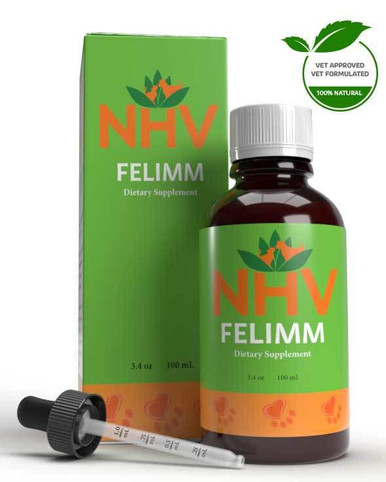
Felimm is a gentle, natural liquid herbal formula that helps support your cat’s immune system, strength, and overall comfort—especially when they’re dealing with FeLV, FIV, respiratory challenges, or weakened immunity.
Made with 12 herbs traditionally used to support whole-body wellness — like turmeric, aloe vera, and gotu kola — Felimm helps your cat by:
Felimm is vet-formulated, made with safe, high-quality herbs, and crafted by NHV — trusted by pet parents and veterinarians for over 25 years. It’s natural support you can feel good about giving when your cat needs extra care.

FeLV and FIV have a strong negative impact on your cat’s immune system and general wellbeing. Left untreated, FeLV can cause serious health issues and other cancers, including lymphoma. Add this natural support to the symptomatic treatment for feline leukemia and FIV that your vet recommends along with diet and nutrition to give them the best fighting chance.
It’s important to help balance your cat’s immune system to help them defend against daily contact with environmental bacteria, fungi, viruses, and protozoa.
NHV’s all-natural supplements for feline leukemia and FIV are formulated by a master herbalist, and a holistic veterinarian with over 20 years of experience.
Felimm for cats contains powerful herbal ingredients that help in fighting viruses and balancing your kitty’s natural immune system.
Add this natural support to the treatment for feline leukemia recommended by your veterinarian. Read more about leukemia and FIV on the holistic veterinarian, Dr. Hillary Cook’s blog.
With the right support cats with FeLV and FIV can lead healthy lives.
NHV offers a Feline Leukemia (FeLV) Kit which is available in both a fighter pack and immune and antioxidant support pack. We also provide a Feline Immunodeficiency Virus (FIV) Kit because, at NHV, we believe in giving our pet parents everything they need to care for their kitty naturally.
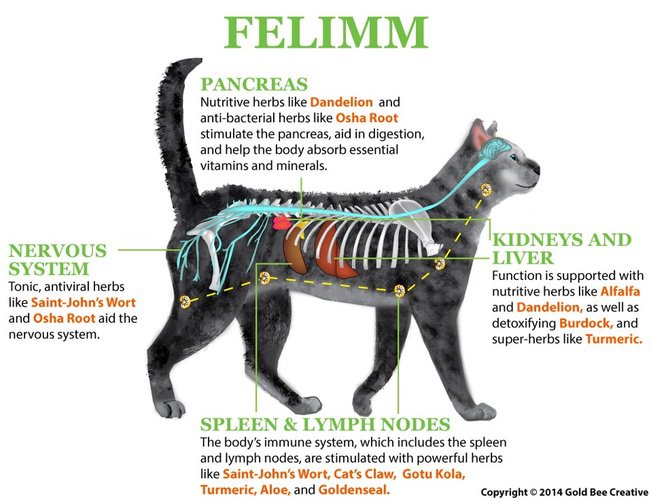
St. John’s Wort – A potent antiviral that helps control viral infections and stimulates your cat’s immune system.
Turmeric – A powerful antioxidant that helps fight the damaging effects of free radicals. It strengthens liver function and contains strong antifungal properties.
Aloe Vera – Contains Acemannan, which has been proposed as an adjunctive therapy for cats with FIV. Aloe also contains high levels of vitamins, minerals, amino acids, and other nutrients important for cats with immune disorders.
Alfalfa – Contains high levels of chlorophyll, which works as an antioxidant in your cat's bloodstream. It also contains nutrients beneficial to cats with immune disorders.
Burdock – Helps cleanse the body of toxins and waste that accumulate during illness. It is also high in calcium, phosphorus, iron, thiamine, and riboflavin.
Cat’s Claw – A powerful anti-inflammatory and antioxidant that supports your cat’s immune system and helps strengthen its defenses against viruses like leukemia.
Osha – A natural immune builder that helps pets fight infections including FeLV and FIV. Also has antibacterial and antiviral properties.
Dandelion – A highly nutritious food that stimulates liver secretion, improves digestion and stimulates appetite. It also protects the kidneys and has anti-inflammatory properties.
Gotu Kola– An antioxidant-rich herb known to strengthen the immune system and protect cells from damage caused by free radicals. Helps calm the nervous system.
Usnea – An immune system stimulant with anti-bacterial and anti-fungal properties that help protect your cat’s weakened immune system from Candida Albicans.
Goldenseal – An immune supporting herb with blood cleansing properties.
Myrrh – Helps control bacterial infections that cats with compromised immune systems are so vulnerable to.
Select your pet's weight to determine the correct dose.
To be taken twice daily. Determine your pet’s weight and then use the easy chart below to determine the correct dose. This is the minimum dosage.
Pet's Weight Dosage
0 - 15 lb = 0.5 ml
16 - 30 lb = 1.0 ml
31 - 45 lb = 1.5 ml
46 - 60 lb = 2.0 ml
61 - 75 lb = 2.5 ml
Over 75 lb = 3.0 ml
How to Administer
Shake well before use. The easiest method is to use the dropper provided and place the drops into your pet’s food or favorite treat. You can also use the dropper and squirt directly into the pet’s mouth. Some pets can be finicky, if this occurs consider hiding the drops in foods most pet’s love such as fish, chicken or yogurt or a favourite treat. If your pet only eats dry food then soak a few kibbles at feeding time.
For Best Results
Herbal dietary supplements are beneficial to the health and well-being of your pet and are safe for long-term use. Every pet responds to natural herbal supplements differently, therefore it is important to be consistent and administer the product daily. Supplements generally take two to four weeks to take effect, however this will vary from one animal to the next.
Product Storage
All NHV Natural Pet Products are pure herbal extracts and contain no artificial additives, preservatives or coloring. Shelf life after opening is 6 months and must be refrigerated after opening.
Cautions and Contraindications
Do not use Felimm in pregnant or nursing animals. Speak to your vet before using our products. A second visit is recommended if your pet’s condition does not improve, or deteriorates after continued use of the supplements.
All information provided by NHV Natural Pet Products is for educational purposes only.
FeLV and FIV have a strong negative impact on your cat’s immune system and general wellbeing. Left untreated, FeLV can cause serious health issues and other cancers, including lymphoma. Add this natural support to the symptomatic treatment for feline leukemia and FIV that your vet recommends along with diet and nutrition to give them the best fighting chance.
It’s important to help balance your cat’s immune system to help them defend against daily contact with environmental bacteria, fungi, viruses, and protozoa.
NHV’s all-natural supplements for feline leukemia and FIV are formulated by a master herbalist, and a holistic veterinarian with over 20 years of experience.
Felimm for cats contains powerful herbal ingredients that help in fighting viruses and balancing your kitty’s natural immune system.
Add this natural support to the treatment for feline leukemia recommended by your veterinarian. Read more about leukemia and FIV on the holistic veterinarian, Dr. Hillary Cook’s blog.
With the right support cats with FeLV and FIV can lead healthy lives.
NHV offers a Feline Leukemia (FeLV) Kit which is available in both a fighter pack and immune and antioxidant support pack. We also provide a Feline Immunodeficiency Virus (FIV) Kit because, at NHV, we believe in giving our pet parents everything they need to care for their kitty naturally.

St. John’s Wort – A potent antiviral that helps control viral infections and stimulates your cat’s immune system.
Turmeric – A powerful antioxidant that helps fight the damaging effects of free radicals. It strengthens liver function and contains strong antifungal properties.
Aloe Vera – Contains Acemannan, which has been proposed as an adjunctive therapy for cats with FIV. Aloe also contains high levels of vitamins, minerals, amino acids, and other nutrients important for cats with immune disorders.
Alfalfa – Contains high levels of chlorophyll, which works as an antioxidant in your cat's bloodstream. It also contains nutrients beneficial to cats with immune disorders.
Burdock – Helps cleanse the body of toxins and waste that accumulate during illness. It is also high in calcium, phosphorus, iron, thiamine, and riboflavin.
Cat’s Claw – A powerful anti-inflammatory and antioxidant that supports your cat’s immune system and helps strengthen its defenses against viruses like leukemia.
Osha – A natural immune builder that helps pets fight infections including FeLV and FIV. Also has antibacterial and antiviral properties.
Dandelion – A highly nutritious food that stimulates liver secretion, improves digestion and stimulates appetite. It also protects the kidneys and has anti-inflammatory properties.
Gotu Kola– An antioxidant-rich herb known to strengthen the immune system and protect cells from damage caused by free radicals. Helps calm the nervous system.
Usnea – An immune system stimulant with anti-bacterial and anti-fungal properties that help protect your cat’s weakened immune system from Candida Albicans.
Goldenseal – An immune supporting herb with blood cleansing properties.
Myrrh – Helps control bacterial infections that cats with compromised immune systems are so vulnerable to.
Select your pet's weight to determine the correct dose.
To be taken twice daily. Determine your pet’s weight and then use the easy chart below to determine the correct dose. This is the minimum dosage.
Pet's Weight Dosage
0 - 15 lb = 0.5 ml
16 - 30 lb = 1.0 ml
31 - 45 lb = 1.5 ml
46 - 60 lb = 2.0 ml
61 - 75 lb = 2.5 ml
Over 75 lb = 3.0 ml
How to Administer
Shake well before use. The easiest method is to use the dropper provided and place the drops into your pet’s food or favorite treat. You can also use the dropper and squirt directly into the pet’s mouth. Some pets can be finicky, if this occurs consider hiding the drops in foods most pet’s love such as fish, chicken or yogurt or a favourite treat. If your pet only eats dry food then soak a few kibbles at feeding time.
For Best Results
Herbal dietary supplements are beneficial to the health and well-being of your pet and are safe for long-term use. Every pet responds to natural herbal supplements differently, therefore it is important to be consistent and administer the product daily. Supplements generally take two to four weeks to take effect, however this will vary from one animal to the next.
Product Storage
All NHV Natural Pet Products are pure herbal extracts and contain no artificial additives, preservatives or coloring. Shelf life after opening is 6 months and must be refrigerated after opening.
Cautions and Contraindications
Do not use Felimm in pregnant or nursing animals. Speak to your vet before using our products. A second visit is recommended if your pet’s condition does not improve, or deteriorates after continued use of the supplements.
All information provided by NHV Natural Pet Products is for educational purposes only.
discomfort support


Support for Discomfort and Appetite Stimulant
buy 2 and save $3
3 month supply for a small to medium size
What is it?
NHV Yucca is used for cats as a supplement to provide nutrients, and may be helpful for discomfort, inflammation, and to increase or balance the appetite.
How does it work?
Why trust it?
NHV supplements are formulated by a veterinarian and master herbalist with a combined 50 years of experience.


What is it?
NHV Yucca is used for cats as a supplement to provide nutrients, and may be helpful for discomfort, inflammation, and to increase or balance the appetite.
How does it work?
Why trust it?
NHV supplements are formulated by a veterinarian and master herbalist with a combined 50 years of experience.

Yucca is used in cat food as well as food for other animals around the world. Its root is a highly nutritious herb that’s rich in vitamin C, beta-carotene, B vitamins, magnesium, iron, calcium, manganese, protein, niacin, and phosphorus.
Yucca contains two very beneficial compounds: sarsasapogenin and smilagenin. These two compounds work on the mucous membranes of the small intestine. These compounds help with the penetration and absorption of minerals and vitamins. Sarsasapogenin and smilagenin are known as steroidal saponins (phytosterols) which act as precursors to corticosteroids produced naturally by the body.
Steroidal saponins support the immune function of the body while stimulating and supporting the production of its own corticosteroids and corticosteroid–related hormones. Due to this action, studies conducted on Yucca have shown that it may be beneficial and effective for discomfort relief and inflammation in conditions such as arthritis. Yucca for cats may also be a natural appetite stimulant and may also help reduce the production of urease, which contributes to the unpleasant odors of urine and feces in some cats.
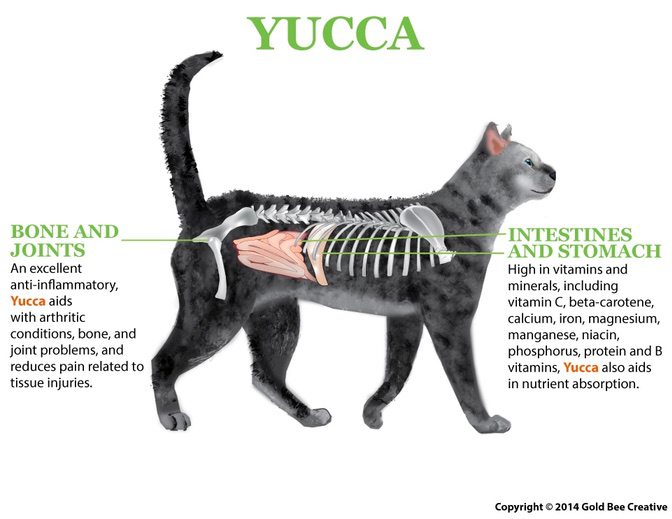
Yucca - Commonly used for supporting arthritis, as an anti-inflammatory, nutritive, antitumor, and digestive supplement.

Select your pet's weight to determine the correct dose.
To be taken twice daily. Determine your pet’s weight and then use the easy chart below to determine the correct dose. This is the minimum dosage.
Pet's Weight Dosage
0 - 15 lb = 0.5 ml
16 - 30 lb = 1.0 ml
31 - 45 lb = 1.5 ml
46 - 60 lb = 2.0 ml
61 - 75 lb = 2.5 ml
Over 75 lb = 3.0 ml
How to Administer: Shake well before use. The easiest method is to use the dropper provided and place the drops into your pet’s food or favorite treat. You can also use the dropper and squirt directly into the pet’s mouth. Some pets can be finicky, if this occurs consider hiding the drops in foods most pet’s love such as fish, chicken, yogurt, or a favorite treat. If your pet only eats dry food then soak a few kibbles at feeding time.
For Best Results: Herbal dietary supplements are beneficial to the health and well-being of your pet and are safe for long-term use. Every pet responds to natural herbal supplements differently, therefore it is important to be consistent and administer the product daily. Supplements generally take two to four weeks to take effect, however this will vary from one animal to the next.
Product Storage:
All NHV Natural Pet Products are pure herbal extracts and contain no artificial additives, preservatives or coloring. Shelf life after opening is 6 months and must be refrigerated after opening.
Cautions and Contraindications
Do not use Yucca in pregnant or nursing animals.
Speak to your vet before using our products. A second visit is recommended if your pet’s condition does not improve, or deteriorates after continued use of the supplements. All information provided by NHV Natural Pet Products is for educational purposes only.
Yucca is used in cat food as well as food for other animals around the world. Its root is a highly nutritious herb that’s rich in vitamin C, beta-carotene, B vitamins, magnesium, iron, calcium, manganese, protein, niacin, and phosphorus.
Yucca contains two very beneficial compounds: sarsasapogenin and smilagenin. These two compounds work on the mucous membranes of the small intestine. These compounds help with the penetration and absorption of minerals and vitamins. Sarsasapogenin and smilagenin are known as steroidal saponins (phytosterols) which act as precursors to corticosteroids produced naturally by the body.
Steroidal saponins support the immune function of the body while stimulating and supporting the production of its own corticosteroids and corticosteroid–related hormones. Due to this action, studies conducted on Yucca have shown that it may be beneficial and effective for discomfort relief and inflammation in conditions such as arthritis. Yucca for cats may also be a natural appetite stimulant and may also help reduce the production of urease, which contributes to the unpleasant odors of urine and feces in some cats.

Yucca - Commonly used for supporting arthritis, as an anti-inflammatory, nutritive, antitumor, and digestive supplement.

Select your pet's weight to determine the correct dose.
To be taken twice daily. Determine your pet’s weight and then use the easy chart below to determine the correct dose. This is the minimum dosage.
Pet's Weight Dosage
0 - 15 lb = 0.5 ml
16 - 30 lb = 1.0 ml
31 - 45 lb = 1.5 ml
46 - 60 lb = 2.0 ml
61 - 75 lb = 2.5 ml
Over 75 lb = 3.0 ml
How to Administer: Shake well before use. The easiest method is to use the dropper provided and place the drops into your pet’s food or favorite treat. You can also use the dropper and squirt directly into the pet’s mouth. Some pets can be finicky, if this occurs consider hiding the drops in foods most pet’s love such as fish, chicken, yogurt, or a favorite treat. If your pet only eats dry food then soak a few kibbles at feeding time.
For Best Results: Herbal dietary supplements are beneficial to the health and well-being of your pet and are safe for long-term use. Every pet responds to natural herbal supplements differently, therefore it is important to be consistent and administer the product daily. Supplements generally take two to four weeks to take effect, however this will vary from one animal to the next.
Product Storage:
All NHV Natural Pet Products are pure herbal extracts and contain no artificial additives, preservatives or coloring. Shelf life after opening is 6 months and must be refrigerated after opening.
Cautions and Contraindications
Do not use Yucca in pregnant or nursing animals.
Speak to your vet before using our products. A second visit is recommended if your pet’s condition does not improve, or deteriorates after continued use of the supplements. All information provided by NHV Natural Pet Products is for educational purposes only.